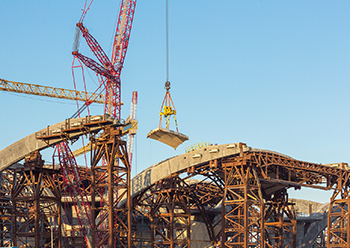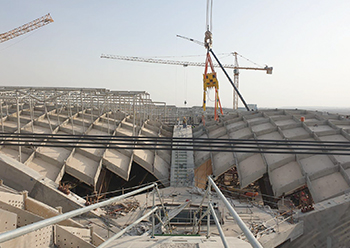Milestone on Kuwait Airport terminal project
The construction prowess of Limak Construction and the technological expertise of Adapa have helped create the massive domes that rise over Kuwait airport’s new terminal.
01 November 2020
Kuwait International Airport marked a major construction milestone last month when contractor Limak Construction cast the last of the 36,964 precast concrete shell cassettes required for the inner roof of its new Terminal 2 (T2) project.
Fabricated entirely on-site, the unique steel and concrete composite structures will cover a total area of 282,179 sq m to form the massive domes that span the terminal’s entire interior space.
Limak Construction is a part of leading Turkish conglomerate Limak Group. Its Project Director Richard Meredith expresses delight at the significant milestone it has achieved with the casting of the last and final shell cassette required for the terminal’s inner roof.
“Limak is proud to commemorate the 100 per cent completion of the fabrication of the shell cassettes, especially given the ever-evolving circumstances caused by the Covic-19 pandemic. We thank our stakeholders and employees for their hard work and dedication in helping reach this significant milestone and extend our sincerest gratitude to the Ministry of Public Works (MPW) for their support,” states Meredith.
 |
|
Installation of the shell cassettes is under way for the roof of the new terminal. |
According to him, around 60 per cent of these cassettes have now been installed since erection commenced in April last year.
The domes of the terminal will be made up of 36,964 shell cassettes in different shapes and sizes specially cured, sandblasted and sealed. The fabrication process was carried out entirely on site.
“At the start of the project, we decided to invest in our own factories with cutting-edge technologies that operate on-site rather than importing materials to combat any long lead times or shortages. This, in return has enabled Limak to continue to operate during these uncertain and unprecedented times,” explains Meredith.
“Taking all the proactive and precautionary measures necessary to keep our construction site and employees safe while continuing work on T2, the factories will continue to operate and produce the materials required for the project and work will continue as scheduled,” he adds.
The unique moulds for the precast concrete shell cassettes were constructed and assembled by Limak in Kuwait, and designed by Adapa, a Danish company specialised in mechanical innovation and computer-aided mould manufacturing.
“We are pleased to be part of the collaboration with Limak, and proud that our adaptive moulds have supported the construction of 37.000 curved precast panels.” Jan Bak, General Manager, Adapa Middle East, tells Gulf Construction.
 |
|
The facility for the production of the precast concrete shells at Kuwait airport site. |
According to Adapa, the precast concrete cassettes have been produced utilising adaptive moulds. The concrete was cast on a reconfigurable flexible surface, which could be adapted according to the information from the CAD model. Contrary to the common way of producing moulds for double-curved geometry CNC milling foam materials, an automated process was developed, thus avoiding labour-intensive operations and waste production, says the company.
“The use of adaptive moulding for the Kuwait International Airport project is a clear step forward in comparison with classic shell structures of the 20th century. The development and integration of automatised processes and a direct chain of control from design to fabrication were fundamental to guarantee the high level of precision required,” says a spokesman for Adapa.
He continues: “The technologies for releasing and revealing the freeform potential in precast concrete is there. All industries are reluctant to investments in new technologies and production techniques, even those demonstrated to be successful. However concrete history indicates that it is the followers that benefit the most by adopting the ground-breaking innovations.
 |
|
The shells will cover an area of 282,179 sq m to form the massive domes of the terminal. |
“History has demonstrated that concrete construction is mainly determined by the mould used and not by the material itself. Therefore, the casting techniques have to be considered as relevant in an integral part of a concrete element. The technologies are present, and they offer automation, rapid process, flexible solutions at low cost and no waste.”
“Concrete holds the potential to become the future material for curved and geometric complex constructions. It just needs to be released from the 2D linear mould imprisonment, to reveal the forbidden curves of precast concrete,” he adds.
The design of the complex structure of Kuwait International Airport was undertaken by German-based firm Werner Sobek, while the roof’s construction methodology was handled by the Robert Bird Group, a member of one of the largest Asia-based urban, industrial, and infrastructure consulting firms.
The T2 project is built to be one of the most advanced and environmentally conscious airports in the world and an iconic gateway to Kuwait.
Targeting to be one of the world’s first LEED (Leadership in Energy and Environmental Design) Gold-certified passenger terminals, the airport will combine the thermal properties of the concrete structure with a large expanse of roof-mounted photovoltaic panels to harvest solar energy.



